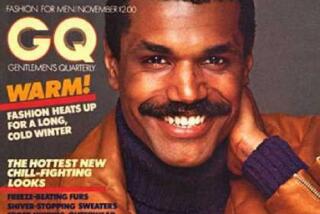Star Vehicle : Di, Liz, Tonya, the Bobbitts . . . For 20 Years, People Has Covered All Types
- Share via
Twenty years ago, they called it a puffy, fluffy, tacky magazine filled with celebrity piffle that could be read cover to cover in the supermarket checkout line.
Some of those same barbs are still being lobbed at People magazine two decades later. But after attaining a circulation of 3.15 million and becoming a Time Inc. money machine, the weekly is laughing all the way to the cash register.
Its 20th anniversary double issue hits the newsstands today, and the hoopla doesn’t end there. With a hardcover book (“People Celebrates People: The Best of 20 Unforgettable Years”), a commemorative soft-bound publication (“20 Years of People Covers”) and a television show (“People’s 20th Birthday,” scheduled to air March 7 on ABC), this birthday seems more a national event than a mere milestone.
Maybe that’s fitting for a magazine that has chronicled popular culture while becoming part of it.
It has given us royal battles (Di versus Charles), battles royal (Mia versus Woody), royal pains (Morton Downey Jr.), plus fads (mood rings), trends (disco), flops (New Coke) losses (Ryan White) and triumphs (the 1980 Olympic gold medal-winning U.S. ice hockey team).
It has determined the Sexiest Man Alive, the Most Intriguing People, and the Best and Worst Dressed.
But People magazine deserves credit for more than its breezy blips and copious black and white photos, its supporters say.
“I think the magazine took the term popular culture and broadened it enormously, just as it broadened the term celebrity ,” says Richard Stolley, the founding editor of People and senior editorial adviser for Time Inc. “If you had asked back then what a celebrity was, the answer would have been someone in entertainment and sports, probably. What People discovered through its correspondents is all these interesting people out there . . . who rose to national prominence in so many other fields.”
People didn’t just broaden the term celebrity , it blew it up to the size of a football field. Springing from the back pages of Life magazine, the weekly debuted on Feb. 28, 1974, cost 35 cents (current price: $2.39) and featured on the cover Mia Farrow coyly biting a strand of pearls. Until then, Americans had gotten their personality news via such newspaper columnists as Walter Winchell and Hedda Hopper, breathless fanzines such as Photoplay or the briefest of mentions in general interest magazines and newspapers.
People also vaulted just-plain folks to instant fame in showcasing what Stolley calls “ordinary people doing extraordinary things,” which has become one of the magazine’s mantras. The Menendez brothers, Lorena Bobbitt and Amy Fisher all qualified for infamy status under this clause. The concept quickly caught on.
“When I worked at Newsweek, it had the Newsmakers section, and it was kind of dumb and dull,” says Edwin Diamond, now media critic for New York magazine. “After People magazine came out, the People section of Time (magazine) was spiffed up, the Newsmakers section of Newsweek was spiffed up, newspapers had columns about Hollywood people, New York people. You can physically see the change, physically measure it in this country.”
Former Editor Stolley suggests that the cultural climate of the ‘70s was ideal for cultivating a personality magazine.
“We had just been through a decade of war, racial tension and protest, and the individual in a sense had gotten buried in things like mass protests,” he says. “By the time the magazine started, a lot of that anger had started to drain out and we were looking at individuals again.”
Television may also have aided People’s explosion, Diamond says. “We had movie stars in the ‘30s, ‘40s and ‘50s, but these people weren’t coming into the house. . . . Television just brought so many previously unknown visages into our homes.”
*
The fallout from People can be seen all over the media, in personality-driven magazines such as US (debuting in 1977) and Vanity Fair (debuting in 1983), plus legions of television news magazines and TV tabloid shows (“Inside Edition” and “Hard Copy”).
But the hunger has led to a feeding frenzy. The competition for access to celebrities--real and manufactured--is cutthroat.
Want Whitney on your magazine cover? Stand in line. Dying to interview the players in a surrogate-mother custody battle? Talk to their agents and pray they haven’t yet made a movie-of-the-week deal. Personalities have become commodities.
“I’m waiting for the New Yorker to start putting celebrities on the cover,” says Landon Y. Jones Jr., managing editor of People since 1989. “There are many more outlets seeking to live off the same universe of stars, and that has driven up the value (of celebrities) enormously. And that’s happening to ordinary people who are thrust into fame. They’re told (by their agent or lawyer) to hold out for the best offer. . . .
“They’re thinking, ‘Why hand this over when we can control this, sell it, extract a higher price?’ Everything’s on the table now and being bargained for (in an interview)--what’s talked about, what’s not talked about, who the writer will be. I would say we’re not exactly Snow White, but most of the stuff we won’t do.”
People won’t promise a cover to a celebrity (“All we’ll say is, ‘We think it’s going to be a cover,’ ” Jones says) and won’t pay for stories, although he knows how the celebrity journalism game is played.
“Do I ask for covers? Sure. Absolutely,” says Pat Kingsley of the top L.A.-based publicity firm PMK, whose clients include Tom Hanks and Tom Cruise.
Does she get them?
“If I don’t, we don’t do the story, at times. You have to understand, this business is so competitive. . . . In order for (a magazine) to get exclusivity, we’ve got to get something in return. Those are the rules. But (the magazines) set that agenda, not us.”
Kingsley concedes that a People cover is “an advantage,” but it’s difficult to say if it translates into higher box office receipts.
“It’s all hopeful,” she says. “It’s something you can’t prove. You just know you have to try. Because the ad dollars are so expensive, you have to have that free publicity.”
*
But sometimes “free” publicity exacts a price. Although she declined to discuss specifics, Kingsley hinted that she has not always been thrilled with People’s treatment of her clients.
“I think there was a time when we didn’t work with (People) for about a year,” Kingsley says. “I don’t want to go into it, it was a promise made that wasn’t kept. But none of those (editors) are there anymore.”
One well-publicized case of a star getting into a snit occurred in 1988, when Robin Williams was profiled in a People cover story.
It chronicled the breakup of Williams’ marriage to Valerie Velardi and cast the couple’s nanny, Marsha Garces (now his wife), as the home-wrecker. “At 35, Robin is caught up in a private turmoil of passion and anguish,” the magazine gushed, reading like the cover blurb of a bodice-ripping romance novel.
Williams was still steamed about the story last fall, saying in an interview with the Los Angeles Times: “They wrote an article basically saying things that were untrue. The idea of home-wrecking is b.s.”
“Does it bother me? Yes,” Jones says of Williams’ anger. “It was six years ago. I’ve talked to him and said, ‘The whole staff of the magazine has changed since the story appeared, why do you keep doing this?’ But you and I would probably feel the same way if it happened to us.”
The struggle for control has led to fewer celebs wanting to tell all, Jones says.
“There are definitely people who are afraid to reveal much of themselves in public at all,” he says. “That’s posed a problem for us because we really like to see people at home, a real look at a real person. It happens, but it’s harder and harder to get. Certain people--certain publicists --are harder to deal with.”
But actress Tracey Gold has done some gut-spilling. A recent cover story updated readers on her struggle with anorexia, first chronicled in a 1992 People cover story.
Why put a semi-obscure television actress on the cover?
“Her cover two years ago was one of our best all-time sellers,” Jones explains. “We knew the public was interested in her and her battle with anorexia and this was a sequel story. It did OK, not the blockbuster we thought it was going to be, but there were no problems.”
*
The magazine’s best newsstand seller was the “John Lennon: A Tribute” cover in 1980; “Prince Charles & Princess Diana: It’s Over” became the all-time highest circulation (subscription and newsstand) issue. And Princess Di has the distinction of being the most popular cover girl, appearing 32 times (followed by Elizabeth Taylor and Fergie, tying at 12 each; Michael Jackson at 10; Cher at 9, and Jacqueline Onassis at 8).
But don’t expect an unending supply of royal covers.
“We had a peak year in 1992,” Jones says. “The royals is Diana--Fergie and Andrew are supporting players in the story of Diana. Now that she truly seems to be heading into private life, even though she may be dating, I don’t think she’ll have the prominence she had before. We haven’t had a Diana cover so far in 1994--and my God, we’re almost out of February!”
If Di does make major headlines again, you can bet People editors will be sizing up cover photos. So will countless other publications, and readers will be sopping up every factoid they can.
Can they distinguish between the information carried in a People or Vanity Fair and the print and broadcast tabloids?
“I used to think that people could distinguish fact from fancy, hype from reality, show business from news, that people are smarter than we give them credit for,” says media critic Diamond. “But I’m beginning to entertain the notion that there’s so much out there that numbness is taking over. Everything is impossibly muddied now. I used to believe that people could make the distinction--I still believe that emotionally, if not intellectually.”
Jones has a bit more faith in his readers: “I think people do know the difference between the tabloids and People. I believe people take our magazine seriously. When it’s a media feeding frenzy, as with Tonya (Harding) and Nancy (Kerrigan), I think we present a reasonable point of view.
“There’s an earthquake, fires, the Whitewater issue--and everyone sits there with their eyes half-closed. But someone comes over and says, ‘Let me tell you what happened to my sister during the earthquake,’ then everyone listens. It’s fundamental to the magazine’s success to find the common human experiences and relate them.”


